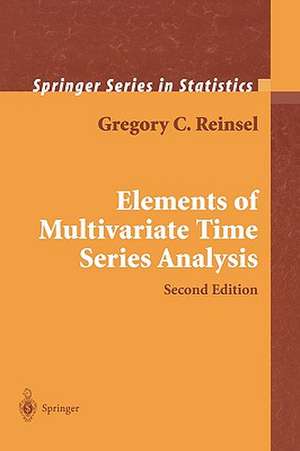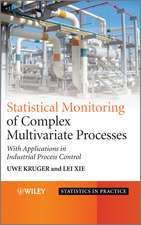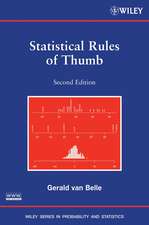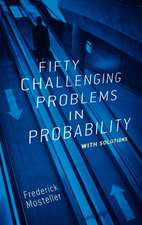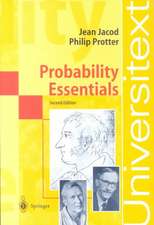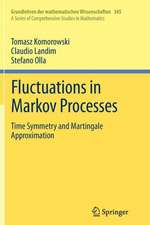Elements of Multivariate Time Series Analysis: Springer Series in Statistics
Autor Gregory C. Reinselen Limba Engleză Paperback – 31 oct 2003
Din seria Springer Series in Statistics
- 14%
 Preț: 679.60 lei
Preț: 679.60 lei - 20%
 Preț: 630.97 lei
Preț: 630.97 lei - 20%
 Preț: 816.43 lei
Preț: 816.43 lei - 20%
 Preț: 1000.84 lei
Preț: 1000.84 lei -
 Preț: 390.84 lei
Preț: 390.84 lei - 20%
 Preț: 697.13 lei
Preț: 697.13 lei - 20%
 Preț: 445.20 lei
Preț: 445.20 lei - 20%
 Preț: 881.51 lei
Preț: 881.51 lei - 18%
 Preț: 1237.14 lei
Preț: 1237.14 lei - 18%
 Preț: 967.22 lei
Preț: 967.22 lei - 18%
 Preț: 956.50 lei
Preț: 956.50 lei - 18%
 Preț: 794.25 lei
Preț: 794.25 lei - 15%
 Preț: 648.05 lei
Preț: 648.05 lei - 18%
 Preț: 1222.49 lei
Preț: 1222.49 lei - 15%
 Preț: 646.11 lei
Preț: 646.11 lei - 15%
 Preț: 647.08 lei
Preț: 647.08 lei - 15%
 Preț: 646.11 lei
Preț: 646.11 lei - 18%
 Preț: 1389.62 lei
Preț: 1389.62 lei - 15%
 Preț: 652.81 lei
Preț: 652.81 lei - 18%
 Preț: 1114.52 lei
Preț: 1114.52 lei - 18%
 Preț: 952.40 lei
Preț: 952.40 lei - 18%
 Preț: 1393.27 lei
Preț: 1393.27 lei - 18%
 Preț: 1561.68 lei
Preț: 1561.68 lei - 18%
 Preț: 1231.47 lei
Preț: 1231.47 lei - 15%
 Preț: 513.64 lei
Preț: 513.64 lei - 18%
 Preț: 893.71 lei
Preț: 893.71 lei - 15%
 Preț: 649.87 lei
Preț: 649.87 lei - 18%
 Preț: 1007.65 lei
Preț: 1007.65 lei - 18%
 Preț: 1111.67 lei
Preț: 1111.67 lei - 18%
 Preț: 1229.10 lei
Preț: 1229.10 lei - 18%
 Preț: 892.74 lei
Preț: 892.74 lei - 18%
 Preț: 913.26 lei
Preț: 913.26 lei - 18%
 Preț: 943.88 lei
Preț: 943.88 lei -
 Preț: 391.61 lei
Preț: 391.61 lei -
 Preț: 391.22 lei
Preț: 391.22 lei - 18%
 Preț: 1391.04 lei
Preț: 1391.04 lei -
 Preț: 390.84 lei
Preț: 390.84 lei - 18%
 Preț: 893.84 lei
Preț: 893.84 lei - 18%
 Preț: 960.61 lei
Preț: 960.61 lei - 18%
 Preț: 1245.34 lei
Preț: 1245.34 lei - 18%
 Preț: 964.54 lei
Preț: 964.54 lei - 15%
 Preț: 643.16 lei
Preț: 643.16 lei - 18%
 Preț: 1674.70 lei
Preț: 1674.70 lei - 15%
 Preț: 643.84 lei
Preț: 643.84 lei - 15%
 Preț: 586.37 lei
Preț: 586.37 lei - 18%
 Preț: 1004.99 lei
Preț: 1004.99 lei - 15%
 Preț: 643.34 lei
Preț: 643.34 lei - 18%
 Preț: 806.40 lei
Preț: 806.40 lei - 18%
 Preț: 727.66 lei
Preț: 727.66 lei
Preț: 392.75 lei
Nou
Puncte Express: 589
Preț estimativ în valută:
75.16€ • 77.65$ • 62.55£
75.16€ • 77.65$ • 62.55£
Carte tipărită la comandă
Livrare economică 26 martie-09 aprilie
Preluare comenzi: 021 569.72.76
Specificații
ISBN-13: 9780387406190
ISBN-10: 0387406190
Pagini: 358
Ilustrații: XVII, 358 p.
Dimensiuni: 155 x 235 x 18 mm
Greutate: 0.53 kg
Ediția:Softcover reprint of the original 2nd ed. 1997
Editura: Springer
Colecția Springer
Seria Springer Series in Statistics
Locul publicării:New York, NY, United States
ISBN-10: 0387406190
Pagini: 358
Ilustrații: XVII, 358 p.
Dimensiuni: 155 x 235 x 18 mm
Greutate: 0.53 kg
Ediția:Softcover reprint of the original 2nd ed. 1997
Editura: Springer
Colecția Springer
Seria Springer Series in Statistics
Locul publicării:New York, NY, United States
Public țintă
ResearchCuprins
1. Vector Time Series and Model Representations.- 1.1 Stationary Multivariate Time Series and Their Properties.- 1.2 Linear Model Representations for a Stationary Vector Process.- A1 Appendix: Review of Multivariate Normal Distribution and Related Topics.- A l. l Review of Some Basic Matrix Theory Results.- A l. 2 Vec Operator and Kronecker Products of Matrices.- A l. 3 Expected Values and Covariance Matrices of Random Vectors.- A1.4 The Multivariate Normal Distribution.- A1.5 Some Basic Results on Stochastic Convergence.- 2. Vector ARMA Time Series Models and Forecasting.- 2.1 Vector Moving Average Models.- 2.2 Vector Autoregressive Models.- 2.3 Vector Mixed Autoregressive Moving Average Models.- 2.4 Nonstationary Vector ARMA Models.- 2.5 Prediction for Vector ARMA Models.- 2.6 State-Space Form of the Vector ARMA Model.- A2 Appendix: Methods for Obtaining Autoregressive and Moving Average Parameters from Covariance Matrices.- A2.1 Iterative Algorithm for Factorization of Moving Average Spectral Density Matrix in Terms of Covariance Matrices.- A2.2 Autoregressive and Moving Average Parameter Matrices in Terms of Covariance Matrices for the Vector ARMA Model.- A2.3 Evaluation of Covariance Matrices in Terms of the AR and MA Parameters for the Vector ARMA Model.- 3. Canonical Structure of Vector ARMA Models.- 3.1 Consideration of Kronecker Structure for Vector ARMA Models.- 3.2 Canonical Correlation Structure for ARMA Time Series.- 3.3 Partial Autoregressive and Partial Correlation Matrices.- 4. Initial Model Building and Least Squares Estimation for Vector AR Models.- 4.1 Sample Cross-Covariance and Correlation Matrices and Their Properties.- 4.2 Sample Partial AR and Partial Correlation Matrices and Their Properties.- 4.3 Conditional Least Squares Estimation of Vector AR Models.- 4.4 Relation of LSE to Yule-Walker Estimate for Vector AR Models.- 4.5 Additional Techniques for Specification of Vector ARMA Models.- A4 Appendix: Review of the General Multivariate Linear Regression Model.- A4.1 Properties of the Maximum Likelihood Estimator of the Regression Matrix.- A4.2 Likelihood Ratio Test of Linear Hypothesis About Regression Coefficients.- A4.3 Asymptotically Equivalent Forms of the Test of Linear Hypothesis.- A4.4 Multivariate Linear Model with Reduced-Rank Structure.- A4.5 Generalization to Seemingly Unrelated Regressions Model.- 5. Maximum Likelihood Estimation and Model Checking for Vector ARMA Models.- 5.1 Conditional Maximum Likelihood Estimation for Vector ARMA Models.- 5.2 ML Estimation and LR Testing of ARMA Models Under Linear Restrictions.- 5.3 Exact Likelihood Function for Vector ARMA Models.- 5.4 Innovations Form of the Exact Likelihood Function for ARMA Models.- 5.5 Overall Checking for Model Adequacy.- 5.6 Effects of Parameter Estimation Errors on Prediction Properties.- 5.7 Motivation for AIC as Criterion for Model Selection, and Corrected Versions of AIC.- 5.8 Numerical Examples.- 6. Reduced-Rank and Nonstationary Cointegrated Models.- 6.1 Nested Reduced-Rank AR Models and Partial Canonical Correlation Analysis.- 6.2 Review of Estimation and Testing for Nonstationarity (Unit Roots) in Univariate ARIMA Models.- 6.3 Nonstationary (Unit-Root) Multivariate AR Models, Estimation, and Testing.- 6.4 A Canonical Analysis for Vector Autoregressive Time Series.- 6.5 Multiplicative Seasonal Vector ARMA Models.- 7. State-Space Models, Kaiman Filtering, and Related Topics.- 7.1 State-Variable Models and Kaiman Filtering.- 7.2 State-Variable Representations of the Vector ARMA Model.- 7.3 Exact Likelihood Estimation for Vector ARMAProcesses with Missing Values.- 7.4 Classical Approach to Smoothing and Filtering of Time Series.- 8. Linear Models with Exogenous Variables.- 8.1 Representations of Linear Models with Exogenous Variables.- 8.2 Forecasting in ARMAX Models.- 8.3 Optimal Feedback Control in ARMAX Models.- 8.4 Model Specification, ML Estimation, and Model Checking for ARMAX Models.- 8.5 Numerical Example.- Appendix: Time Series Data Sets.- Exercises and Problems.- References.- Author Index.
